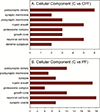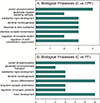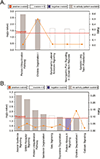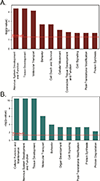Persistent proteomic changes in glutamatergic and GABAergic signaling in the amygdala of adolescent rats exposed to chlorpyrifos as juveniles
- PMID: 34058248
- PMCID: PMC8276847
- DOI: 10.1016/j.neuro.2021.05.012
Persistent proteomic changes in glutamatergic and GABAergic signaling in the amygdala of adolescent rats exposed to chlorpyrifos as juveniles
Abstract
Chlorpyrifos (CPF) remains one of the most widely used organophosphorus insecticides (OPs) despite the concerns about its developmental neurotoxicity. Developmental exposure to CPF has long-lasting negative impacts, including abnormal emotional behaviors. These negative impacts are observed at exposure levels do not cause inhibition of acetylcholinesterase, the canonical target of OPs. Exposure to CPF at these levels inhibits the endocannabinoid metabolizing enzyme fatty acid amide hydrolase (FAAH) but it is not clear what the persistent effects of this inhibition are. To investigate this, male rat pups were exposed orally to either corn oil, 0.75 mg/kg CPF, or 0.02 mg/kg PF-04457845 (PF; a specific inhibitor of FAAH) daily from postnatal day 10 (PND10) - PND16. This dosage of CPF does not inhibit brain cholinesterase activity but inhibits FAAH activity. On PND38 (adolescence), the protein expression in the amygdala was determined using a label-free shotgun proteomic approach. The analysis of control vs CPF and control vs PF led to the identification of 44 and 142 differentially regulated proteins, respectively. Gene ontology enrichment analysis revealed that most of the proteins with altered expression in both CPF and PF treatment groups were localized in the synapse-related regions, such as presynaptic membrane, postsynaptic density, and synaptic vesicle. The different biological processes affected by both treatment groups included persistent synaptic potentiation, glutamate receptor signaling, protein phosphorylation, and chemical synaptic transmission. These results also indicated disturbances in the balance between glutamatergic (↓ Glutamate AMPA receptor 2, ↓ Excitatory amino acid transporter 2, and ↑ vesicular glutamate transporter 2) and GABAergic signaling (↑ GABA transporter 3 and ↑ glutamate decarboxylase 2). This imbalance could play a role in the abnormal emotional behavior that we have previously reported. These results suggest that there is a similar pattern of expression between CPF and PF, and both these chemicals can persistently alter emotional behavior as a consequence of inhibition of FAAH.
Keywords: Chlorpyrifos; Developmental; Endocannabinoid; GABA; Glutamate; Organophosphates.
Copyright © 2021 Elsevier Inc. All rights reserved.
Conflict of interest statement
Declaration of interests
The authors declare that they have no known competing financial interests or personal relationships that could have appeared to influence the work reported in this paper.
Figures






References
-
- Ahn K, Smith SE, Liimatta MB, Beidler D, Sadagopan N, Dudley DT, Young T, Wren P, Zhang Y, Swaney S, Van Becelaere K, Blankman JL, Nomura DK, Bhattachar SN, Stiff C, Nomanbhoy TK, Weerapana E, Johnson DS, Cravatt BF, 2011. Mechanistic and pharmacological characterization of PF-04457845: A highly potent and selective fatty acid amide hydrolase inhibitor that reduces inflammatory and noninflammatory pain. Journal of Pharmacology and Experimental Therapeutics 338(1), 114–124. - PMC - PubMed
-
- Aldridge JE, Meyer A, Seidler FJ, Slotkin TA, 2005b. Developmental exposure to terbutaline and chlorpyrifos: pharmacotherapy of preterm labor and an environmental neurotoxicant converge on serotonergic systems in neonatal rat brain regions. Toxicology and Applied Pharmacology 203(2), 132–144. - PubMed
-
- Aldridge JE, Seidler FJ, Slotkin TA, 2004. Developmental exposure to chlorpyrifos elicits sex-selective alterations of serotonergic synaptic function in adulthood: critical periods and regional selectivity for effects on the serotonin transporter, receptor subtypes, and cell signaling. Environmental Health Perspectives 112(2), 148–155. - PMC - PubMed
Publication types
MeSH terms
Substances
Grants and funding
LinkOut - more resources
Full Text Sources
Molecular Biology Databases

